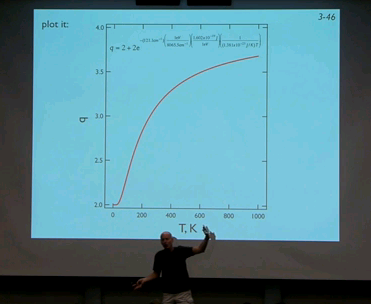UCI Chem 131C Thermodynamics and Chemical Dynamics (Spring 2012)
Lec 03. Thermodynamics and Chemical Dynamics -- Energy and q (The Partition Function) --
View the complete course: ../courses/chem_131c_thermodynamics_and_chemical_dynamics.html
Instructor: Reginald Penner, Ph.D.
License: Creative Commons BY-NC-SA
Terms of Use: ../info.
More courses at http://ocw.uci.edu
Description: In Chemistry 131C, students will study how to calculate macroscopic chemical properties of systems. This course will build on the microscopic understanding (Chemical Physics) to reinforce and expand your understanding of the basic thermo-chemistry concepts from General Chemistry (Physical Chemistry.) We then go on to study how chemical reaction rates are measured and calculated from molecular properties. Topics covered include: Energy, entropy, and the thermodynamic potentials; Chemical equilibrium; and Chemical kinetics. This video is part of a 27-lecture undergraduate-level course titled "Thermodynamics and Chemical Dynamics" taught at UC Irvine by Professor Reginald M. Penner.
Thermodynamics and Chemical Dynamics (Chem 131C) is part of OpenChem: ../openchem/
Recorded on April 6, 2012.
Index of Topics:
00:19 - Example-A certain atom has a threefold degenerate ground level...
01:02 - Function for Calculating Degeneracy of Energy Levels
01:24 - Sum of Three Energy Levels
03:35 - We need to calculate the thermal energy kT, in units...
04:22 - Energy Level Diagram
07:20 - Example: The four lowest electronic energy levels of atomic C have energies and degeneracies as follows...
07:51 - Equation: Partition Function
08:32 - In this case, q will have four terms - one for each state
08:49 - How to Calculate the Four Terms
09:59 - Example: 9.27 of 14 total states in C...
10:24 - does this makes sense (calculating thermal energy again)
10:56 - Diagram-Electronic States of Carbon
12:53 - now find the fractional population of each level for C...
14:51 - Diagram: ...now, it will be obvious to you that W must depend on energy...
15:45 - Partition Function (W must depend on energy, but how?)
20:03 - Example: the NO molecule has a doubly degenerate excited electronic level...
21:03 - Diagram--Wave Numbers
22:05 - Example - The NO molecule has a doubly degenerate excited electronic level... (continued)
22:40 - Plot (Diagram)
23:38 - Calculating Term Populations
Required attribution: Penner, Reginald Thermodynamics and Chemical Dynamics 131C (UCI OpenCourseWare: University of California, Irvine), ../courses/chem_131c_thermodynamics_and_chemical_dynamics.html. [Access date]. License: Creative Commons Attribution-ShareAlike 3.0 United States License.


